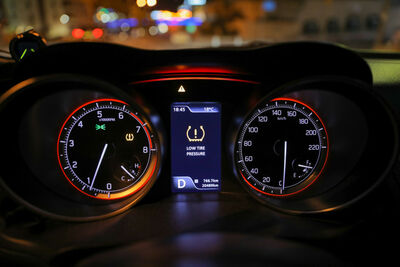Air Pressure Light On? AAA Says Don't Let Tire Pressure Monitors Leave You Feeling Flat
Automotive engineers put pressure sensors to the test
A new study by AAA finds that in-vehicle tire pressure monitoring systems (TPMS) are generally accurate, but to be certain, motorists should still check their tire pressure manually. Tires are the only part of the car that come in contact with the road, and proper inflation is the key to safety and better gas mileage.
Whether in rain, sleet, snow, or dry conditions, tires are designed to work best when properly inflated," said Mike Hoshaw, vice president of automotive services, AAA East Central. “Even though AAA research finds that tire pressure monitoring systems work as intended, a tire can be more than 20% deflated before it triggers the dashboard warning.â€???Â
Using 2022-2024 models, AAA engineers evaluated 11 passenger vehicles including sedans, pickups and SUVs, with "direct TPMS, which uses air pressure sensors mounted in each wheel. According to the AAA study the average percentage difference between displayed and actual tire pressure was between 1.2% and -1.5%, depending on tire location. Additionally, the amber warning TPMS light illuminated when tires were underinflated to 75% of the posted pressure (located on the sticker inside the door jam) for five of eleven test vehicles. Five of the six remaining test vehicles illuminated the TPMS warning dashboard light when tires were deflated from 70.3 to 72.9% of posted pressure, depending on the test vehicle.
Key findings from the study:
- No significant error in displayed tire pressure readings was noted for any vehicles evaluated within the study.
- The largest percentage difference in reported vs. actual tire pressure was 3.3% percent.
- The large pickup truck had a significantly higher posted pressure than other test vehicles.
- One vehicle did not illuminate the TPMS warning light even when one of its tires was deflated to only 65% of the recommended posted pressure, despite the immediate update of pressure readings in the instrument cluster.
AAA's recommendations:
AAA encourages motorists to check their tire pressure monthly (either in the instrument cluster or using a gauge), even if their TPMS light is not illuminated. And with winter approaching, it’s important to remember that cold weather makes the air denser, so the pressure in the tire is reduced, triggering a dashboard warning. Do not ignore the warning even if the light goes off after driving because the tire is likely low. For this reason, tire pressure should be checked when cold.
Please refer to the full report for methodology details - including specific vehicle makes/models, tire brands and specifications, and testing equipment.
AAA East Central is a not-for-profit association with 69 local offices in Kentucky, New York, Ohio, Pennsylvania and West Virginia serving 2.7 million members. News releases are available at news.eastcentral.aaa.com.



